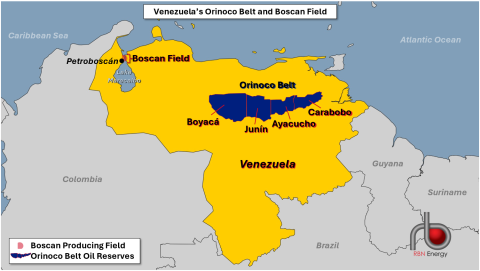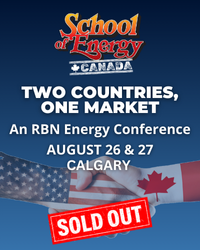The Trump administration announced on February 26 that it is ending Chevron’s permit to operate in oil-rich Venezuela, which will halt U.S. imports of Venezuelan crude by early April. These changes, combined with other recent developments, are likely to significantly impact complex U.S. Gulf Coast refiners relying on heavy crude. In today’s RBN blog, we’ll discuss these impacts — an issue our Refined Fuels Analytics (RFA) practice examined in its recently updated Future of Fuels report.
First, some background. Chevron and its corporate predecessors have more than a 100-year history of operations in Venezuela. Chevron’s legacy company, Venezuelan Gulf Oil, began drilling in 1924, spurring commercial oil production there, and followed that up with operations at Lake Maracaibo and the Boscan Field (tiny, pink-shaded area in Figure 1 below) in northwestern Venezuela. Then-President Carlos Andrés Pérez nationalized Venezuela’s oil industry in 1976 and established Petróleos de Venezuela S.A. (PDVSA) as the state-owned oil company, but despite the nationalization, Chevron remained, and it was asked to form joint ventures (JVs) with PDVSA. In 2006-07, then-President Hugo Chávez’s regime increased royalties and taxes on foreign oil companies and made other changes that prompted some companies — including ExxonMobil and ConocoPhillips — to leave Venezuela.
Figure 1. Venezuela’s Orinoco Belt and Boscan Field. Source: RBN
But Chevron hung on, attracted by Venezuela’s vast reserves and the ability to produce oil at low costs. By staying put, Chevron agreed to give up majority control of its operations to PDVSA. Still, it retained 40% interests and continued to be involved in several onshore and offshore projects, including Petroboscán in western Venezuela, while focusing on extra-heavy oil production in three blocks within the Carabobo area of the Orinoco Belt (blue-shaded area in Figure 1 above).
There have been other ups and downs for Chevron along the way, resulting in a mostly downward trend for Venezuelan crude exports to the U.S. in recent years (see Figure 2 below). For instance, the first Trump administration, in August 2017, imposed economic sanctions on Venezuela that resulted in lower oil production and reduced exports to the U.S. It followed that up in April 2020 by ordering Chevron to wind down its production in Venezuela, although the Biden administration later reversed the order. The Biden administration eased sanctions in October 2022 and allowed Chevron to increase production for sales to the U.S.
Join Backstage Pass to Read Full Article








